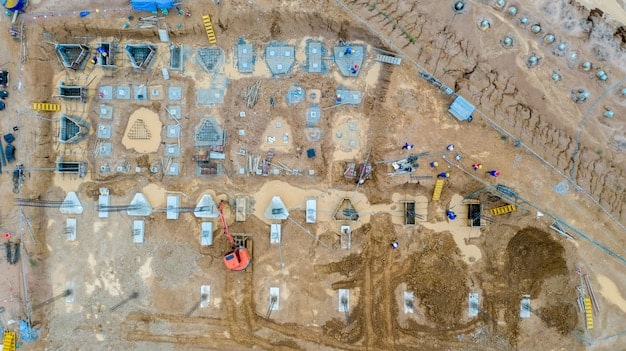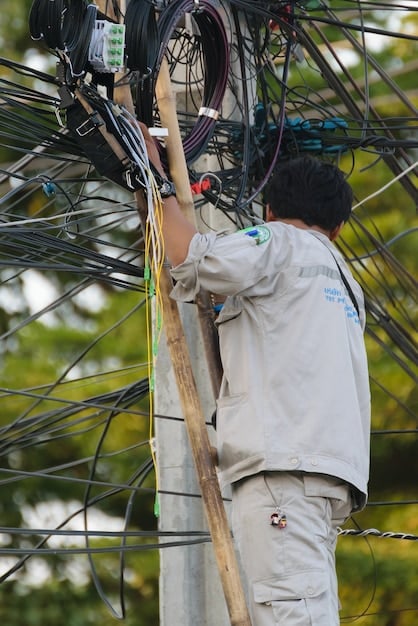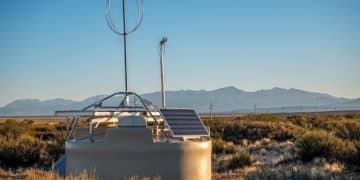How Infrastructure Spending Will Reshape US Businesses in 2025

The New Federal Infrastructure Spending Bill, set to significantly impact US businesses in 2025, is poised to modernize infrastructure, create jobs, and stimulate economic growth through investments in roads, bridges, broadband internet, and renewable energy.
The New Federal Infrastructure Spending Bill impacts US businesses in 2025 by injecting billions into the economy, leading to new opportunities and challenges. This investment promises to modernize the nation’s infrastructure and transform how businesses operate.
Understanding the Scope of the Infrastructure Bill
The Infrastructure Investment and Jobs Act, signed into law, represents a monumental commitment to revitalizing America’s aging infrastructure. This bill’s expansive scope touches nearly every facet of the US economy, setting the stage for significant changes in 2025.
Understanding its key provisions is crucial for businesses to anticipate and capitalize on the opportunities it presents. The bill’s focus extends beyond traditional infrastructure projects, incorporating investments in emerging technologies and sustainable solutions.
Key Investment Areas
The infrastructure bill targets several critical areas for improvement and expansion, each with the potential to drive business growth and innovation. These investments will not only modernize existing systems but also create new markets and opportunities.
- Transportation: Investments in roads, bridges, public transit, and railways aim to improve connectivity and efficiency, reducing transportation costs and travel times for businesses.
- Broadband Internet: Expanding access to high-speed internet is crucial for businesses to compete in the digital age, particularly in rural and underserved areas.
- Energy and Utilities: Modernizing the power grid and investing in renewable energy sources will enhance energy reliability and promote sustainable business practices.
- Water Infrastructure: Upgrading water systems and addressing water scarcity issues will ensure a reliable water supply for businesses and communities.
These key investment areas are interconnected, with improvements in one sector often leading to positive ripple effects in others. For example, improved transportation infrastructure can facilitate the expansion of broadband internet access in rural areas.

How the Bill Creates Opportunities for US Businesses
The infrastructure bill is inherently designed to stimulate economic activity, creating a wide range of opportunities for US businesses across various sectors. These opportunities extend beyond direct construction contracts, impacting supply chains, technology providers, and service industries.
By understanding these opportunities, businesses can strategically position themselves to benefit from the increased demand and investment spurred by the bill.
Construction and Engineering
The most immediate impact of the infrastructure bill will be felt in the construction and engineering sectors. These industries will see a surge in demand for their services as projects get underway across the country.
From small contractors to large engineering firms, businesses in these sectors will have the chance to bid on projects, expand their operations, and create jobs.
Technology and Innovation
The bill also allocates significant funding for technology and innovation, particularly in areas such as smart infrastructure and renewable energy. This creates opportunities for tech companies and startups to develop and deploy cutting-edge solutions.
- Smart Infrastructure: Implementing technologies to monitor and manage infrastructure assets, improving efficiency and reducing maintenance costs.
- Renewable Energy: Developing and deploying renewable energy solutions, such as solar and wind power, to create a cleaner and more sustainable energy future.
- Electric Vehicle Infrastructure: Building a national network of electric vehicle charging stations will support the growth of the electric vehicle market.
The emphasis on technology and innovation reflects a broader trend towards using data-driven approaches to improve infrastructure performance and sustainability. This shift will require businesses to adapt and embrace new technologies.
Potential Challenges and How to Navigate Them
While the infrastructure bill presents significant opportunities for US businesses, it also introduces potential challenges that require careful planning and strategic decision-making. These challenges range from workforce shortages to regulatory compliance.
By anticipating these challenges and developing proactive solutions, businesses can mitigate risks and maximize their chances of success.

Workforce Shortages
One of the most pressing challenges facing the construction industry is a shortage of skilled workers. As demand for construction services increases, businesses may struggle to find qualified personnel to fill critical roles.
Addressing this challenge requires a multi-faceted approach, including investing in training programs, attracting new workers to the industry, and leveraging technology to improve productivity.
Supply Chain Disruptions
The global supply chain has been disrupted in recent years, leading to shortages of materials and components. These disruptions can increase costs and delay project timelines.
- Diversifying Suppliers: Reducing reliance on single suppliers can help mitigate the impact of supply chain disruptions.
- Building Inventory: Maintaining adequate inventory levels can provide a buffer against unexpected shortages.
- Collaborating with Suppliers: Working closely with suppliers to improve communication and coordination can help ensure a reliable supply of materials.
Effective supply chain management is essential for businesses to navigate the challenges posed by global disruptions and maintain profitability.
The Long-Term Economic Impacts of the Bill
The infrastructure bill is not just a short-term stimulus package; it is a long-term investment in America’s economic future. The bill’s impacts will be felt for years to come, shaping the business landscape and creating new opportunities for growth and innovation.
Understanding the long-term implications of the bill is crucial for businesses to make informed decisions and plan for the future.
Increased Productivity
Improved infrastructure can lead to increased productivity across various sectors. For example, reduced transportation costs and travel times can improve the efficiency of supply chains and logistics operations.
Similarly, expanded access to broadband internet can enable businesses to adopt new technologies and improve communication and collaboration.
Job Creation
The infrastructure bill is expected to create millions of jobs, both directly and indirectly. These jobs will span a wide range of industries, from construction and engineering to technology and manufacturing.
- Direct Jobs: Construction workers, engineers, and other professionals directly involved in infrastructure projects.
- Indirect Jobs: Workers in industries that support infrastructure projects, such as manufacturing, transportation, and services.
- Induced Jobs: Jobs created as a result of increased economic activity spurred by infrastructure investments.
The creation of new jobs will boost consumer spending and further stimulate economic growth.
Preparing Your Business for 2025
As the infrastructure bill’s provisions take effect in 2025, US businesses must take proactive steps to prepare for the changes ahead. This includes assessing their current capabilities, identifying potential opportunities, and developing strategies to capitalize on them.
By taking a proactive approach, businesses can position themselves for success in the evolving business environment.
Assess Your Current Capabilities
The first step in preparing for the infrastructure bill is to assess your business’s current capabilities. This includes evaluating your resources, expertise, and competitive advantages.
Identifying your strengths and weaknesses will help you determine which opportunities are the best fit for your business.
Identify Potential Opportunities
Once you have assessed your capabilities, you can begin to identify potential opportunities related to the infrastructure bill. This includes researching specific projects, understanding government procurement processes, and networking with industry partners.
Being proactive in identifying opportunities will give you a head start on the competition.
Develop a Strategic Plan
The final step is to develop a strategic plan that outlines how your business will capitalize on the opportunities created by the infrastructure bill. This plan should include specific goals, timelines, and resource allocations.
A well-defined strategic plan will provide a roadmap for success and help you stay focused on your objectives.
Case Studies: Businesses Benefiting from Infrastructure Spending
Examining real-world examples of businesses that have already benefited from infrastructure spending can provide valuable insights and inspiration. These case studies demonstrate the potential impact of the infrastructure bill and offer practical lessons for other businesses.
By learning from these examples, businesses can gain a better understanding of how to navigate the challenges and opportunities presented by the bill.
- Company A: A construction company that secured a contract to rebuild a bridge, creating jobs and stimulating economic activity in the local community.
- Company B: A technology company that developed a smart infrastructure solution that improved the efficiency of a local water system.
- Company C: A renewable energy company that built a solar farm, providing clean energy and reducing carbon emissions.
These case studies highlight the diverse range of opportunities available to businesses across various sectors. By embracing innovation and collaboration, businesses can play a key role in modernizing America’s infrastructure and driving economic growth.
| Key Aspect | Brief Description |
|---|---|
| 🏗️ Infrastructure Projects | Modernization of roads, bridges, and public transit. |
| 🌐 Broadband Expansion | Increased internet access across the US, particularly in rural areas. |
| ⚡ Renewable Energy | Investments in solar, wind, and other clean energy sources. |
| 💼 Business Opportunities | Creation of contracts and opportunities for growth across many sectors. |
Frequently Asked Questions
▼
The Infrastructure Investment and Jobs Act is a federal law that allocates billions of dollars to repair and upgrade America’s infrastructure, including roads, bridges, broadband, and energy systems.
▼
The bill provides funding for expanding broadband internet access, particularly in rural and underserved areas, improving connectivity and enabling more businesses to operate online.
▼
The bill invests in renewable energy projects, such as solar and wind power, to enhance energy sustainability and reduce carbon emissions, promoting a cleaner energy future.
▼
Businesses in construction, engineering, technology, and manufacturing can benefit from the Act through project contracts, increased demand, and the need for innovative solutions.
▼
Businesses should assess their capabilities, identify potential opportunities related to infrastructure projects, and develop strategic plans to capitalize on the bill’s provisions, ensuring they are competitive.
Conclusion
The New Federal Infrastructure Spending Bill represents a transformative investment in the future of the United States. As businesses prepare for 2025, understanding the bill’s provisions, navigating potential challenges, and capitalizing on emerging opportunities will be crucial for success and sustainable growth.





